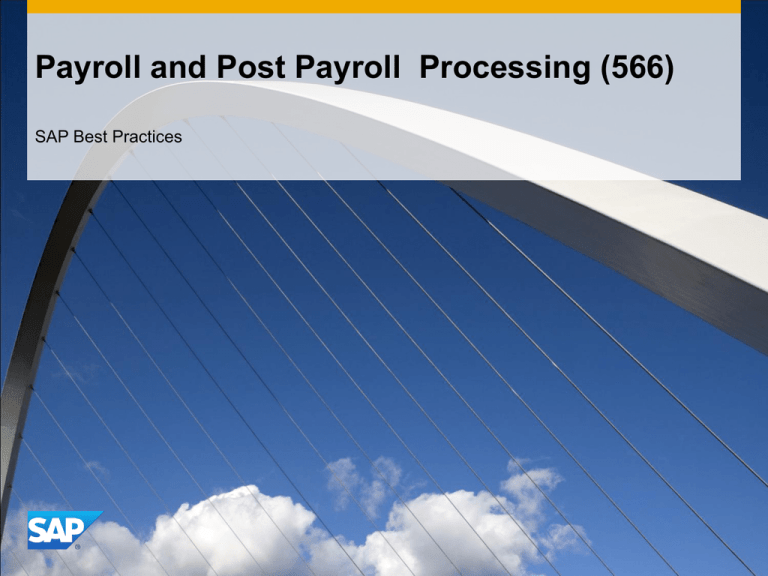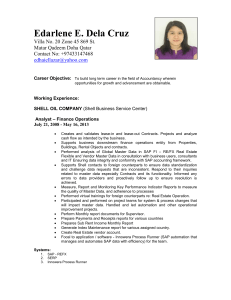
Payroll and Post Payroll Processing (566)
SAP Best Practices
Purpose, Benefits, and Key Process Steps
Purpose
To calculate the gross and net pay, which comprises the individual payments and deductions that are calculated during a payroll period, and are received by an
employee
Execute and manage payroll processing which encompasses (starting payroll, payroll corrections, remuneration statements, payroll journal, garnishment reporting,
wage type report)
Execute bank transfer activities (Data Medium Exchange (DME) Processing and Print Check functionality
Execute third party remittance for taxation, benefit vendors and garnishment processing
Support management of FMLA using the FMLA workbench
Full integration and payroll posting to SAP FI/CO
Benefits
Automated, efficient processing of employees’ payroll
Automated processing of banking activities
Automated processing of third party remittance
Integration with SAP Financials
Sample payroll forms
Key Process Steps
Maintain Master Data and Time Data
Run US Payroll
Run Simulations and production runs for FI/CO Posting and 3rd Party Remittance
Pre-DME, DME Management and check processing
Third Party Remittance
Posting to FI/CO activities
Payroll journal reporting
© 2011 SAP AG. All rights reserved.
2
Required SAP Applications and Company Roles
Required SAP Applications
SAP enhancement package 5 for SAP ERP 6.0
Enterprise roles involved in process flows
Payroll Administrator
© 2011 SAP AG. All rights reserved.
3
Detailed Process Description
Payroll Processing
Run Payroll
– After all employee master data changes are entered into the system for the relevant payroll period, the
payroll is released in order to execute and run payroll for the pay period selected. If any errors occur,
they must be corrected before you can exit the payroll. Prior to exiting payroll, a simulation of the third
party remittance and finance posting is recommended.
DME Activities
– Once payroll has been run without errors, the Pre-program data medium exchange (PreDME) program
is run for all employees in order to process data for a bank transfer (direct deposit) or check payment.
The DME – Payment workbench is run for employees who have elected to be paid using direct bank
transfer. For employees who are paid by check, the Check payment program will need to be executed.
© 2011 SAP AG. All rights reserved.
4
Detailed Process Description
Subsequent Payroll Activities
Third Party Remittance Processing
This business process allows you to complete tasks related to vendor remittances
for employee deductions. They are:
Generating bank transfer and check payments to third parties, such as tax authorities and
benefits providers
Reconciling payments made in FI with payables data stored in HR.
© 2011 SAP AG. All rights reserved.
5
Detailed Process Description
Subsequent Processing
Posting to FI activities
The payroll results contain information that is relevant for Accounting. For this reason, they
must be evaluated for posting to Accounting. The Posting to Accounting component
performs this task. It is the interface between Payroll and Accounting. It helps to:
– Group together posting-relevant information from the payroll results
– Create summarized documents
– Perform the relevant postings in the Accounting components
Payroll Reporting
In order to facilitate reconciliation of payroll payments various reports can be run such as
the wage type reporter, payroll journal, garnishments report, and the payroll reconciliation
report
© 2011 SAP AG. All rights reserved.
6
Process Flow Diagram
Triggering
Event
Benefits Enrollment and Termination Processing
Workforce
Management
(563, 567, 568,
569, 570)
Maintain
Payroll
Control
Record (PA03)
Accounts
Payable
Accountant
Payroll Administrator
Preliminary
Data Medium
Exchange
(DME)
© 2011 SAP AG. All rights reserved.
Workforce
Benefits
Administratio
n
(565, 575)
Workforce
Time Mgmt
(564, 571, 572,
573)
Execute
Payroll
Simulation
Set Payroll
Area
Release
Payroll
PY in
Error?
Display
Remuneration
Statement
Create DME
Print
Employee
Checks
Yes
No
Start Payroll
Payroll
Corrections
Exit Payroll
Third Party
Remittance
(New) As
Simulation
Execute FI
Posting Run
as Simulation
Payroll
Journal
Wage Type
Reporter
Execute FI
Posting Run
Process FI
Posting Run
Execute Bank
Payroll
Reconciliation
Program
Garnishment
Details
Reconcile
Posings
Process
Posing Run
for Third Party
Remit. Run
Create Posting
Run for Third
Party
Remittance
Third Party
Remittance
Display
Payroll
Results
Delete Payroll
Results
Run
Remittance
Completeness
Check
Cash
Management
(160)
Post Manual
Outgoing
Payment
Post
Payments
Using
Payment
Program
7
Legend
<Function>
Symbol
Description
Usage Comments
Band: Identifies a user role, such as Accounts
Payable Clerk or Sales Representative. This band
can also identify an organization unit or group,
rather than a specific role.
Role band contains
tasks common to that
role.
Symbol
Diagram
Connection
The other process flow symbols in this table go
into these rows. You have as many rows as
required to cover all of the roles in the scenario.
External
to SAP
External Events: Contains events that start or end
the scenario, or influence the course of events in
the scenario.
Business
Activity / Event
Unit Process
Process
Reference
SubProcess
Reference
Process
Decision
Usage Comments
To next / From last Diagram: Leads
to the next / previous page of the
Diagram
Flow chart continues on the next /
previous page
Hardcopy / Document: Identifies a
printed document, report, or form
Does not correspond to a task
step in a document; instead, it is
used to reflect a document
generated by a task step; this
shape does not have any outgoing
flow lines
Financial Actuals: Indicates a
financial posting document
Does not correspond to a task
step in a document; instead, it is
used to reflect a document
generated by a task step; this
shape does not have any outgoing
flow lines
Budget Planning: Indicates a
budget planning document
Does not correspond to a task
step in a document; instead, it is
used to reflect a document
generated by a task step; this
shape does not have any outgoing
flow lines
Manual Process: Covers a task
that is manually done
Does not generally correspond to
a task step in a document;
instead, it is used to reflect a task
that is manually performed, such
as unloading a truck in the
warehouse, which affects the
process flow.
Existing Version / Data: This block
covers data that feeds in from an
external process
Does not generally correspond to
a task step in a document;
instead, this shape reflects data
coming from an external source;
this step does not have any
incoming flow lines
System Pass / Fail Decision: This
block covers an automatic
decision made by the software
Does not generally correspond to
a task step in the document;
instead it is used to reflect an
automatic decision by the system
that is made after a step has been
executed.
Hardcopy /
Document
Flow line (solid): Line indicates the normal
sequence of steps and direction of flow in the
scenario.
Flow line (dashed): Line indicates flow to
infrequently-used or conditional tasks in a
scenario. Line can also lead to documents involved
in the process flow.
Connects two tasks in
a scenario process or
a non-step event
Business Activity / Event: Identifies an action that
either leads into or out of the scenario, or an
outside Process that happens during the scenario
Does not correspond
to a task step in the
document
Unit Process: Identifies a task that is covered in a
step-by-step manner in the scenario
Corresponds to a task
step in the document
Financial
Actuals
Process Reference: If the scenario references
another scenario in total, put the scenario number
and name here.
Corresponds to a task
step in the document
Sub-Process Reference: If the scenario references
another scenario in part, put the scenario number,
name, and the step numbers from that scenario
here
Corresponds to a task
step in the document
Process Decision: Identifies a decision / branching
point, signifying a choice to be made by the end
user. Lines represent different choices emerging
from different parts of the diamond.
Does not usually
correspond to a task
step in the document;
Reflects a choice to
be made after step
execution
© 2011 SAP AG. All rights reserved.
Description
Budget
Planning
Manual
Process
Existing
Version /
Data
System
Pass/Fail
Decision
8
© 2011 SAP AG. All rights reserved
No part of this publication may be reproduced or transmitted in any form or for any purpose
without the express permission of SAP AG. The information contained herein may be
changed without prior notice.
Some software products marketed by SAP AG and its distributors contain proprietary
software components of other software vendors.
Microsoft, Windows, Excel, Outlook, and PowerPoint are registered trademarks of Microsoft
Corporation.
IBM, DB2, DB2 Universal Database, System i, System i5, System p, System p5, System x,
System z, System z10, System z9, z10, z9, iSeries, pSeries, xSeries, zSeries, eServer,
z/VM, z/OS, i5/OS, S/390, OS/390, OS/400, AS/400, S/390 Parallel Enterprise Server,
PowerVM, Power Architecture, POWER6+, POWER6, POWER5+, POWER5, POWER,
OpenPower, PowerPC, BatchPipes, BladeCenter, System Storage, GPFS, HACMP,
RETAIN, DB2 Connect, RACF, Redbooks, OS/2, Parallel Sysplex, MVS/ESA, AIX,
Intelligent Miner, WebSphere, Netfinity, Tivoli and Informix are trademarks or registered
trademarks of IBM Corporation.
Linux is the registered trademark of Linus Torvalds in the U.S. and other countries.
Adobe, the Adobe logo, Acrobat, PostScript, and Reader are either trademarks or
registered trademarks of Adobe Systems Incorporated in the United States and/or other
countries.
Oracle and Java are registered trademarks of Oracle Corporation.
UNIX, X/Open, OSF/1, and Motif are registered trademarks of the Open Group.
Citrix, ICA, Program Neighborhood, MetaFrame, WinFrame, VideoFrame, and MultiWin are
trademarks or registered trademarks of Citrix Systems, Inc.
Business Objects and the Business Objects logo, BusinessObjects, Crystal Reports, Crystal
Decisions, Web Intelligence, Xcelsius, and other Business Objects products and services
mentioned herein as well as their respective logos are trademarks or registered trademarks
of Business Objects Software Ltd. Business Objects is an SAP company.
Sybase and Adaptive Server, iAnywhere, Sybase 365, SQL Anywhere, and other Sybase
products and services mentioned herein as well as their respective logos are trademarks or
registered trademarks of Sybase, Inc. Sybase is an SAP company.
All other product and service names mentioned are the trademarks of their respective
companies. Data contained in this document serves informational purposes only. National
product specifications may vary.
The information in this document is proprietary to SAP. No part of this document may be
reproduced, copied, or transmitted in any form or for any purpose without the express prior
written permission of SAP AG.
This document is a preliminary version and not subject to your license agreement or any
other agreement with SAP. This document contains only intended strategies, developments,
and functionalities of the SAP® product and is not intended to be binding upon SAP to any
particular course of business, product strategy, and/or development. Please note that this
document is subject to change and may be changed by SAP at any time without notice.
SAP assumes no responsibility for errors or omissions in this document. SAP does not
warrant the accuracy or completeness of the information, text, graphics, links, or other items
contained within this material. This document is provided without a warranty of any kind,
either express or implied, including but not limited to the implied warranties of
merchantability, fitness for a particular purpose, or non-infringement.
HTML, XML, XHTML and W3C are trademarks or registered trademarks of W3C®, World
Wide Web Consortium, Massachusetts Institute of Technology.
SAP shall have no liability for damages of any kind including without limitation direct,
special, indirect, or consequential damages that may result from the use of these materials.
This limitation shall not apply in cases of intent or gross negligence.
SAP, R/3, SAP NetWeaver, Duet, PartnerEdge, ByDesign, SAP BusinessObjects Explorer,
StreamWork, SAP HANA, and other SAP products and services mentioned herein as well
as their respective logos are trademarks or registered trademarks of SAP AG in Germany
and other countries.
The statutory liability for personal injury and defective products is not affected. SAP has no
control over the information that you may access through the use of hot links contained in
these materials and does not endorse your use of third-party Web pages nor provide any
warranty whatsoever relating to third-party Web pages.
© 2011 SAP AG. All rights reserved.
9





